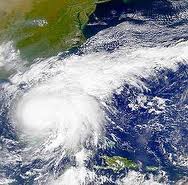
 The storm has been downgraded to a category one hurricane but that good news must be tempered with expectations of rain, rain and more rain plus storm surges. Even as a category one, Hurricane Irene is still going to pack a wallop with maximum sustained winds of 90 mph (140 kph).
The storm has been downgraded to a category one hurricane but that good news must be tempered with expectations of rain, rain and more rain plus storm surges. Even as a category one, Hurricane Irene is still going to pack a wallop with maximum sustained winds of 90 mph (140 kph).
Irene is expected to make landfall near Atlantic Beach, North Carolina between 8am and 10am Saturday morning. Its fury is already being felt as reports come in of power having been knocked out for almost 200,000 customers in the region. Officials are warning everyone to be prepared for flooding as predictions are putting the potential rainfall at 10 inches (25 cm). Considering the amount of rain some areas have already had this summer, experts are also warning that this rain probably will not have anywhere to go which will further increase the danger of flooding.
Due to the rotation of the storm, coastal areas are going to be hit with storm surges with forecasts placing the height at 12 feet (4 metres). How is a 12 foot storm surge going to affect more built-up areas such as New York is anybody’s guess. The next few days are going to have some interesting stories as people try to deal with more water than they have had to in some time.
Preliminary estimates have put the damage so far in the Bahamas and the Dominican Republic at $3.1 billion. Add on top of that what will eventually happen along the Eastern Seaboard and the total will be much higher. Back in 1999, Hurricane Floyd which followed the same path as Irene caused a total of nearly $6 billion in damages plus 57 fatalities.
Published on Aug 27, 2011 by AssociatedPress
Hurricane Irene Slams Into North Carolina Coast
Forecasters say Irene’s sustained hurricane-force winds have slammed into the North Carolina coast. Irene is expected to continue churning its way up the U.S. East Coast through some of the most densely populated areas of the United States.(Aug. 27)
Published on Aug 27, 2011 by Euronews
Two million evacuated as Hurricane Irene hits US
More than two million people on America’s east coast have been told to leave their homes to spare them from Hurricane Irene, which has already been battering North Carolina. They include a quarter of a million New Yorkers along the city’s southern coastal rim. The mass evacuation is taking place ahead of the storm’s expected arrival there on Sunday. Now reported to be a thousand kilometres wide, Irene has weakened slightly to a Category 1 hurricane but still threatens tens of millions of people with winds of around 150 kilometres an hour.
Uploaded by ABCNews on Aug 26, 2011
Hurricane Irene 2011: Are People’s Homes Ready to Survive the East Coast Storm?
ABC News’ Jim Avila examines why some houses survive hurricanes and others don’t.
Uploaded by ABCNews on Aug 26, 2011
Hurricane Irene: Riding Into the Eye with Storm Chasers
Steve Osunsami rides into the eye of the storm with scientists on a mission.
Uploaded by brucecause on Aug 27, 2011
Raw footage: Hurricane Irene The Aftermath in Bahamas
Hurricane Irene Aug. 25, 2011. The Aftermath at about 10:40 a.m. West Bay Street heading east with the winds still strong. Nassau Bahamas
References
Wikipedia: Hurricane Irene (2011)
Hurricane Irene is an active Atlantic hurricane that inflicted extensive damage to many Caribbean nations, and is currently threatening the East Coast of the United States and Atlantic Canada. The ninth named storm and both the first hurricane and major hurricane of the 2011 season, Irene formed from a well-defined Atlantic tropical wave, which showed signs of organization east of the Lesser Antilles. It developed atmospheric convection and a closed cyclonic circulation center, prompting the National Hurricane Center to initiate public advisories on the tropical cyclone late on August 20. Subsequent convective organization occurred as it passed the Leeward Islands, and by August 21 it moved very close to Saint Croix. The next day Irene made landfall near Puerto Rico, where high winds and intermittent torrents caused significant property damage.
Click HERE to read more from William Belle
Article viewed at: Oye! Times at www.oyetimes.com

Be the first to comment